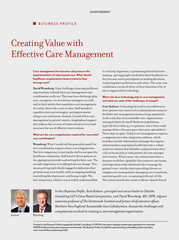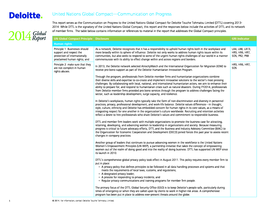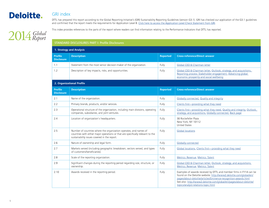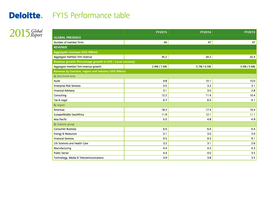Description
ADVERTISEMENT
content, which can help to standardize care delivery
across the continuum. Unfortunately, such a comprehensive solution is hard to find. There are literally
hundreds of vendor products available that have
many of the capabilities, but no one system does it all.
Instead, healthcare organizations may have to consider
a multi-vendor, best-of-breed solution to meet all their
needs. At Deloitte, we utilize technology and analytics
solutions with a combination of vendor solution and
best practices to provide that holistic approach.
How can effective care management improve outcomes
while reducing costs?
Wennberg: Patient navigation guides the patient to
the most appropriate, cost-effective care setting.
If a healthcare provider is treating a diabetic patient, and he or she developed a care coordination strategy and good relationship with that patient, the patient is more likely to call the physician or provider first before heading to the emergency department (ED). This keeps patients out of the acute care setting, because you can proactively address issues, assess their symptoms telephonically or direct them to the primary care setting as opposed to the ER—all of which reduce costs. Also, self-management—getting patients to engage in their care for chronic conditions, such as diabetes or obesity—is the least expensive, and in many ways the most effective care strategy if you’re in a risk-based contract. Kolesar: Technology prioritizes those patients who are most likely at risk clinically or financially, such as high care utilizers or those who frequent high-cost sites.
An automated solution can put these individuals at the top of a care manager’s to-do list and thereby avoid escalating clinical conditions and related high costs. In addition, care management solutions that embed leading practices for a particular condition in provider workflow, permit organizations to deliver care with less variance which has been shown to enhance outcomes and potentially lower costs. What are the additional investments healthcare organizations will have to make to gain core competencies, and does this mean they should consider outsourcing? Kolesar: Most care management organizations reside in entities outside the health system walls, so there can be significant startup costs required to establish the enterprise, invest in new technology and human resources. Return on these investments will be a number of years away, given that revenue is predicated on successfully delivering good care, changing behaviors, achieving improved clinical outcomes and effectively managing the risk-based arrangement.
By working with third parties that provide technology and people solution platforms in an outsourced, subscription, or per-member-per-month pricing model, organizations can avoid the significant upfront capital outlay. As healthcare organizations begin to operationalize care management with the move to value based payment, what are some insights you can share for the future? Wennberg: Organizations will also need to rethink skillsets and how they will accomplish day-to-day tasks, as some fairly radical changes are going to occur in the next 10 years. Everyone from the care coordinator to the organization’s CFO will have to shift their thinking. For instance, getting accustomed to tracking patient health using the telephone, text, or email, will be challenging for some.
Certain organizations will embrace change while others may accept it gradually. To be successful long-term, organizations must think about the competencies of their senior executives and care management staff as well as their abilities to enable stronger care management. Kolesar: Technology will continue to play an everincreasing role in gathering a wider array of data to both track patient care and alert providers to patient issues. I’m referring to technology such as fitness wearables and remote medical devices that monitor heart rate, glucose levels, weight, and so on.
The challenge is what to do with this information and whether or not to encourage patients to use such devices. A lot of this data is not actionable, unless there are sophisticated algorithms and analytics that can take the information and provide insight either in the form of an updated risk score, alert, or direct-to-patient communication. At Deloitte, we leverage analytics platforms to provide solutions for healthcare organizations facing these challenges today.
It’s very exciting, innovative work. Are there any additional materials you recommend for providers to improve their value based care strategies? Kolesar: For more on value based care insights and thought leadership, visit www.deloitte.com/us/vbc This published piece is provided for advertisement purposes. HFMA does not endorse the published material or warrant or guarantee its accuracy. The statements and opinions of those profiled are those of the individual and not those of HFMA.
References to commercial manufacturers, vendors, products, or services that appear do not constitute endorsement by HFMA. .
If a healthcare provider is treating a diabetic patient, and he or she developed a care coordination strategy and good relationship with that patient, the patient is more likely to call the physician or provider first before heading to the emergency department (ED). This keeps patients out of the acute care setting, because you can proactively address issues, assess their symptoms telephonically or direct them to the primary care setting as opposed to the ER—all of which reduce costs. Also, self-management—getting patients to engage in their care for chronic conditions, such as diabetes or obesity—is the least expensive, and in many ways the most effective care strategy if you’re in a risk-based contract. Kolesar: Technology prioritizes those patients who are most likely at risk clinically or financially, such as high care utilizers or those who frequent high-cost sites.
An automated solution can put these individuals at the top of a care manager’s to-do list and thereby avoid escalating clinical conditions and related high costs. In addition, care management solutions that embed leading practices for a particular condition in provider workflow, permit organizations to deliver care with less variance which has been shown to enhance outcomes and potentially lower costs. What are the additional investments healthcare organizations will have to make to gain core competencies, and does this mean they should consider outsourcing? Kolesar: Most care management organizations reside in entities outside the health system walls, so there can be significant startup costs required to establish the enterprise, invest in new technology and human resources. Return on these investments will be a number of years away, given that revenue is predicated on successfully delivering good care, changing behaviors, achieving improved clinical outcomes and effectively managing the risk-based arrangement.
By working with third parties that provide technology and people solution platforms in an outsourced, subscription, or per-member-per-month pricing model, organizations can avoid the significant upfront capital outlay. As healthcare organizations begin to operationalize care management with the move to value based payment, what are some insights you can share for the future? Wennberg: Organizations will also need to rethink skillsets and how they will accomplish day-to-day tasks, as some fairly radical changes are going to occur in the next 10 years. Everyone from the care coordinator to the organization’s CFO will have to shift their thinking. For instance, getting accustomed to tracking patient health using the telephone, text, or email, will be challenging for some.
Certain organizations will embrace change while others may accept it gradually. To be successful long-term, organizations must think about the competencies of their senior executives and care management staff as well as their abilities to enable stronger care management. Kolesar: Technology will continue to play an everincreasing role in gathering a wider array of data to both track patient care and alert providers to patient issues. I’m referring to technology such as fitness wearables and remote medical devices that monitor heart rate, glucose levels, weight, and so on.
The challenge is what to do with this information and whether or not to encourage patients to use such devices. A lot of this data is not actionable, unless there are sophisticated algorithms and analytics that can take the information and provide insight either in the form of an updated risk score, alert, or direct-to-patient communication. At Deloitte, we leverage analytics platforms to provide solutions for healthcare organizations facing these challenges today.
It’s very exciting, innovative work. Are there any additional materials you recommend for providers to improve their value based care strategies? Kolesar: For more on value based care insights and thought leadership, visit www.deloitte.com/us/vbc This published piece is provided for advertisement purposes. HFMA does not endorse the published material or warrant or guarantee its accuracy. The statements and opinions of those profiled are those of the individual and not those of HFMA.
References to commercial manufacturers, vendors, products, or services that appear do not constitute endorsement by HFMA. .









